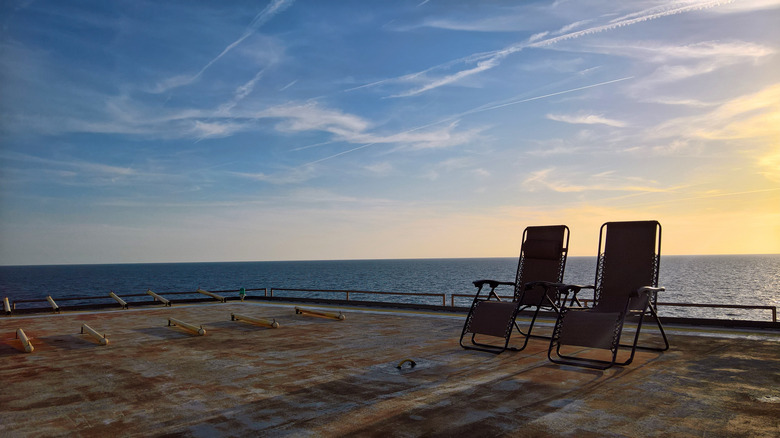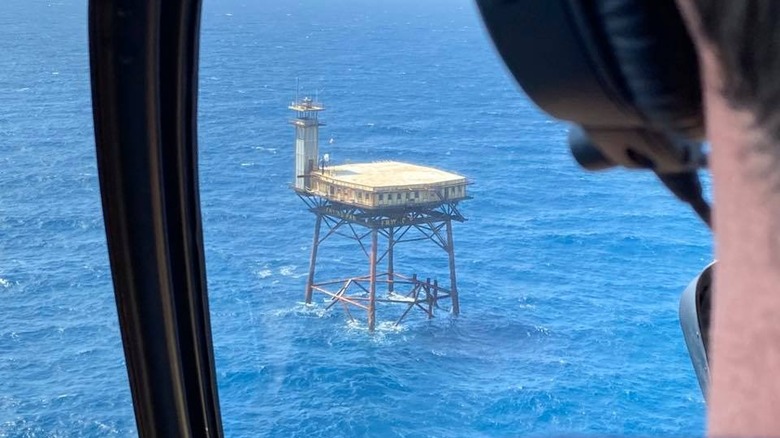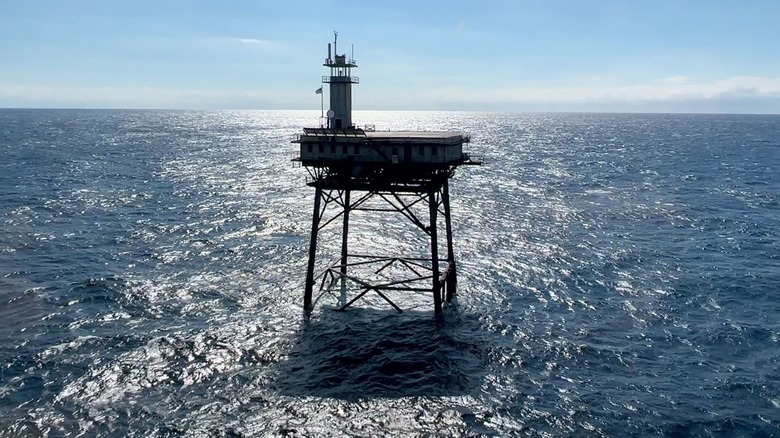This Totally Unique Hotel In The US Is Considered The Most Dangerous In The World
Just 32 miles off the coast of North Carolina, there's a solar-powered hotel on stilts with the words "Frying Pan" emblazoned across it. Welcome to Frying Pan Tower, a defunct, 80-foot lighthouse surrounded by a vast expanse of ocean. If it looks like an oil rig, that's because the tower was converted from a Texas drilling platform into a lighthouse. The Coast Guard erected it in 1964 to replace an older lightship and illuminate the hazardous Frying Pan Shoals. This shallow, 28-mile stretch of sandbars extends from the Cape Fear River into the "Graveyard of the Atlantic," an area that's been a magnet for hundreds of shipwrecks.
Equipped with a backup generator and high-speed internet, the tower takes its name from the shoals, which are said to resemble a pan or skillet on maps. However, its rusty legs, topped by a helipad, also give the impression of a corroded cooking appliance, like a grill, half-submerged in the sink. When the government auctioned it off in 2010, a man named Richard Neal bought the tower for $85,000. Now, through Neal's nonprofit organization — FPTower Inc. — it's undergoing restoration work as an environmental research station and ecotourist destination.
In 2016, Architectural Digest asked, "Could this be the most dangerous hotel in the world?" Since then, it's become a common refrain online that, yes, Frying Pan Tower certainly looks and feels that dangerous. Chalk it up to how exposed the tower is to the elements and how precariously high it's perched above shark-inhabited waters.
Have an ecotourism adventure at Frying Pan Tower
While the West Coast has its one-of-a-kind airplane home attraction, Frying Pan Tower is the only surviving "Texas Tower" of its kind open to the public on the East Coast. A $1,950 ecotourism adventure buys you a long weekend stay here from Thursday to Monday. There are two ways to reach the tower: by boat or helicopter. The former involves being hoisted up on a wooden swing in a lifejacket with your feet dangling as docile sand tiger sharks (never mind their jagged teeth) circle below.
Guests can go snorkeling or scuba diving alongside the sharks and barracuda, weather permitting. You can also catch and cook fish from the tower's walkways. Despite this, the Frying Pan Shoals are a protected reef, which is why the tower wasn't demolished after the Coast Guard abandoned it in 2004. Since then, Frying Pan Tower has survived more than one hurricane, with some of the tattered American flags it's flown now decorating the walls around its original pool table from 1964.
One queen-sized room in the tower is named "Roanoke" after a lighthouse near the island where the New World's infamous "Lost Colony" disappeared (leaving behind one of the world's most mysterious places). On the helipad, you can watch the sunset and enjoy leisure activities like golf with biodegradable fish-food balls. At night, there's a small fireworks show, and it's the perfect place for star-gazing, as you're otherwise far from land and its light pollution.
Save money and aid the restoration effort as a volunteer
As hard as Frying Pan Tower is to reach, even Amazon delivers to it, with help from a third-party carrier flying out of the Cape Fear Regional Jetport. While it's not on our list of North Carolina filming locations you need to visit, that's the same Cape Fear that inspired the movie title. The tower might inspire tinges of real fear, but there's another, cheaper way to visit it that's more realistic than mailing yourself in an Amazon box with air holes.
If you're a welder, painter, or electrician, or you have other skills you can contribute to the tower's restoration, a volunteer trip runs $900 — less than half the cost of an ecotourist trip. This covers the expenses of round-trip transportation by charter vessel along with meals and accommodations for a five-day excursion. You'll be working four hours a day, but you can spend the rest of the time engaged in recreation like Richard Neal, who's prone to unicycling across the helipad.
Note that no one can set foot on Frying Pan Tower without signing a release waiver that absolves Neal's nonprofit group of any liability in the event of an accident. On the tower's website, the FAQ for volunteers disclaims, "This facility is out in the open ocean and is a very dangerous place where foolish action can result in serious consequences very quickly." You'll be in international waters without immediate hospital access, so be careful out there.


